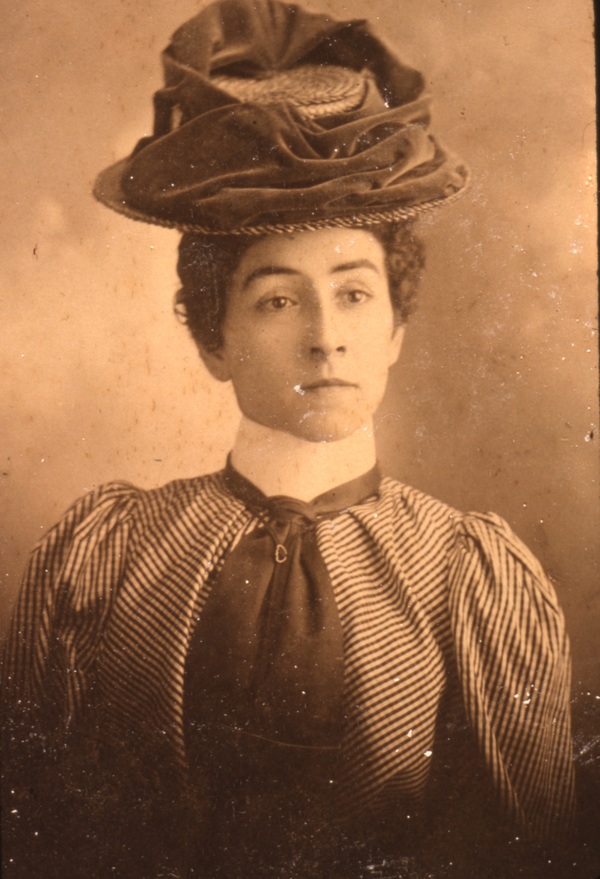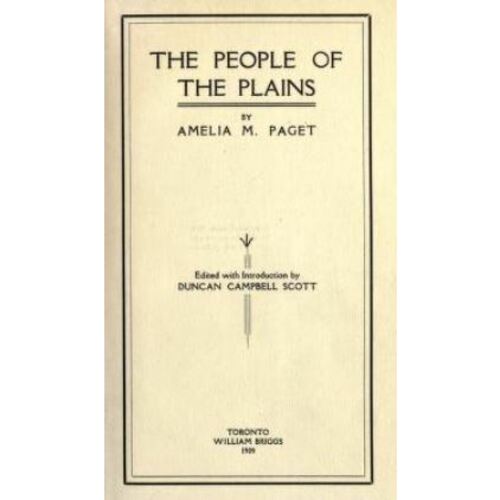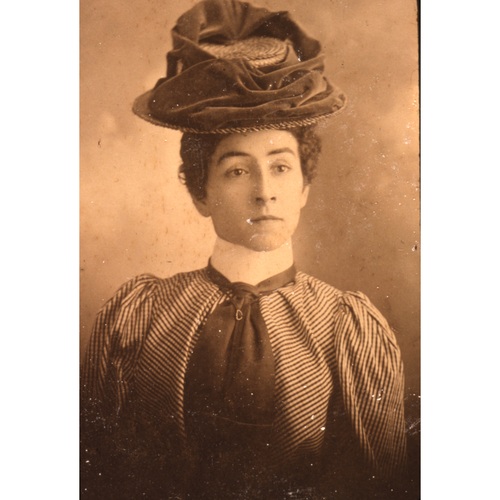
Source: Link
McLEAN, AMELIA ANNE (Paget), linguist and author; b. 15 July 1867 at Fort Simpson (N.W.T.), daughter of William James McLean and Helen Hunter Murray; m. 1899 Frederick Henry Paget, and they had a daughter; d. 10 July 1922 in Ottawa.
Amelia McLean’s family had roots steeped in fur trade history. Her mother was the daughter of Alexander Hunter Murray*, a chief trader with the Hudson’s Bay Company. It was at Fort Simpson that Helen met and married W. J. McLean, a native of the Isle of Lewis, Scotland, who had joined the HBC in 1859. Amelia, the eldest of their 12 children, spent her earliest years at Fort Liard (N.W.T.). In 1873 her father was transferred to Fort Qu’Appelle (Sask.), where his family joined him the following year.
The McLeans arrived at a time of critical change for the aboriginal people of the district because of the collapse of the buffalo economy, treaties, and settlement on reserves. Treaty No.4, which Helen McLean signed as a witness, was made at Fort Qu’Appelle in September 1874. Amelia and her siblings became well acquainted with the Plains Cree and the Saulteaux, forming friendships and attending special ceremonies. Amelia was particularly gifted at languages – she would, for example, translate popular songs into Cree and Saulteaux. During some of the family’s years at Fort Qu’Appelle, she attended St John’s College Ladies’ School in Winnipeg.
Posted in 1883 to Fort Ellice and then Île-à-la-Crosse, in 1884 W. J. McLean was assigned to Fort Pitt on the Saskatchewan River, in the territory of the Woods Cree. Amelia and the family joined him later that year, their arrival coinciding with the move of Plains Cree chief Big Bear [Mistahimaskwa*] and his followers into the district. He had only agreed to take treaty in 1882, following years of meagre subsistence for his people, and the winter of 1884–85 was one of great want and discontent. On 3 April 1885 the McLeans and the other residents of Fort Pitt learned that members of Big Bear’s band had killed nine men at Frog Lake (Alta); a week before, an encounter at Duck Lake between the North-West Mounted Police and the Métis had left 15 dead.
Early in April non-aboriginal people from surrounding settlements sought refuge in Fort Pitt, which housed a NWMP detachment under the command of Francis Jeffrey Dickens*. The three eldest McLean girls, and one of their brothers, took turns at sentry duty. (An illustration in the Montreal Daily Star on 23 May would bear the caption “Noble women on the defensive: the Misses McLean show great courage, each one rifle in hand, stands at a loophole.”) On 13 April the fort was surrounded by Big Bear and about 250 men; the next day W. J. McLean was requested to meet them. Consultation stopped when the Cree believed they were being attacked as three scouts tried to gallop through for the safety of the fort. One was killed; another, wounded, was brought into the fort while Amelia and others provided covering fire; the third escaped but was later taken by the Cree. Three Cree were also killed. Concerned about their father, Amelia and her sister Katherine (Kitty) left the fort and walked into the Cree camp unescorted. According to family accounts, some of the Cree, astonished at the girls’ nerve, asked if they were not scared. The 17-year-old Amelia replied, in perfect Cree: “Why should we be afraid of you. We have lived together as brothers and sisters for many years. We speak the same language. Why should we be afraid of you?” Under her father’s leadership, the remaining residents of Fort Pitt – the police had escaped – agreed to evacuate it under the custody of Big Bear. The group travelled to Frog Lake and then to Frenchman Butte, where there was a confrontation with the pursuing field force of Thomas Bland Strange. The camp fled, only to face another encounter, with NWMP scouts under Samuel Benfield Steele*. In mid June the McLeans were allowed to leave and on the 24th they arrived back at Fort Pitt.
During their months with the Cree, rumours had circulated that the older McLean girls were being mistreated, that they had been made the “slaves of the lesser chiefs” and had suffered the “final outrage.” None of these stories was true, though there had been threatening behaviour from individuals as camp discipline deteriorated. Newspapers of the day commented at length on the girls, who were described as “plucky enough for life guardsmen,” and Amelia was singled out for shouldering her Winchester at Fort Pitt. According to one account, she “would not have believed the endurance they all manifested possible, but now that the captivity is over she looks back at most of it with enjoyment.”
In the American west, women like the McLean sisters might have enjoyed greater notoriety, perhaps in the style of Annie Oakley. Amelia, however, returned to a quiet life at Lower Fort Garry, Man., where her father was in charge from 1886 to 1893. During these years, with linguistic skills that were highly valued, she did some work for the federal Department of Indian Affairs. Its chief accountant and superintendent of Indian education, Duncan Campbell Scott*, who was also a published poet, later wrote that “she was gifted with a language-sense which made possible a knowledge of the subtlest peculiarities of two languages, the Cree and Ojibwa, both highly expressive, but the last eminently flexible and poetic.” In 1899 she married Frederick Paget and moved to Ottawa. A clerk in Scott’s offices, Paget was also useful to his department for his advice on western Indians (he had been a chief clerk at the Indian office in Regina and an assistant to the Indian commissioner). In this regard Amelia would have been an asset as well.
In 1906, in response to a special request from Governor General Lord Grey*, she received a commission from the department to travel among the Plains Indians and interview elders concerning their history, customs, and folklore. She visited the File Hills, Moose Mountain, Muscowpetung, and Crooked Lake agencies in Saskatchewan in the fall of 1906, and met extensively with friends from her Qu’Appelle years. She required neither a driver nor, except when meeting with the Assiniboin, an interpreter, and she camped out unless the weather was poor. Her method was to gather together several elders: when one began telling his or her narrative, the others would corroborate, make corrections, and add detail. She was aware that beliefs limited the telling of fictitious stories to the winter – only actual happenings were recited in the long summer evenings – so she intended more trips, but it is unclear whether any took place. Her small commission was an unusual expenditure for the normally parsimonious government, but, as Scott would explain in his introduction to the resulting book, The people of the plains (Toronto, 1909), the project was motivated by a belief that ancient customs and manners were disappearing. He may also have found Amelia’s insights useful to his poetry. She knew a great deal about the places and some of the individuals he wrote about, such as hunter/runner Akoose of the Crooked Lake agency and his father Qui-witch.
Amelia Paget’s People of the plains is a remarkable and unconventional book. It contains none of the pejorative, negative descriptions of Indian habits and characteristics typically featured in other publications of the time (and before), including the work of Egerton Ryerson Young*. Paget’s focus is the Plains Cree and the Saulteaux. She stresses that, before the arrival of immigrants, they led an ideal existence since they were a wealthy people who had all they desired and a nourishing diet, experienced no sickness, and lived in roomy tepees. After describing their modes of travel and how camping places were chosen and tepees constructed, she writes that “such an encampment amid beautiful scenery, astir with prosperous and contented Indians, must have been a most striking illustration of the Indians’ own idea of the wonderful love and care bestowed upon them by the Great Spirit.” She argues that it is unfair to call them heathens, and provides evidence of their complex religious beliefs. In her detailed descriptions of their ceremonies and dances, she distinguishes between those that were solemn and those intended to cause merriment. The book also contains accounts of the vanished buffalo hunt, warfare, burial customs, poetry, music, legends, and humour.
The way in which Paget undermines dominant stereotypes is most evident in her descriptions of women. Having talked with female elders who had observed “all the triumphs and trials” of their bands, she could maintain that the “popular idea of the poor Indian woman doing all the hard work has too often been overdrawn.” The practice of polygamy is presented sympathetically: the wives “called each other ‘sister,’ and . . . divided their labours equally, and tried in every way to cultivate mutual forbearance.”
Paget’s descriptions of Cree and Saulteaux life challenged conventional assumptions to such an extent that, in his introduction, Scott found it necessary to explain why the book had a “tone of championship for all Indians” and to account for the “idealistic tendency which places everything in a high and favorable aspect.” He suggests that her early experiences, including her months with the Cree in 1885, had caused her to have a glowing view of bygone days and to ignore any “hardship and squalor, starvation, inhumanity and superstition in this aboriginal life.” Paget had little say over the final appearance of her book. Scott edited it and corresponded with the publisher about the title, design, and illustrations. Her original title, which was in Cree or Saulteaux, and her design for the cover, drawn by one of her sisters, were both rejected.
The public was not entirely prepared for the point of view expressed in People of the plains, and it received mixed responses. Some appreciated the author’s “first-hand information” and tendency to upset “popular superstitions.” Others, however, found her account too much of a departure from the deeply embedded stereotypes of the day. The reviewer for the Montreal Standard, for instance, commented that “even when free from contact with the white man they were not exactly the Arcadian shepherds and shepherdesses that Mrs. Paget presents . . . the cruelty, the squalor, the dirt are glossed over. It is too late in the day for any Fenimore Cooper romance of the redskin.”
Amelia McLean Paget died on 10 July 1922 in Ottawa following a four-year decline caused by pernicious anaemia. Her funeral took place at her father’s home in Winnipeg and she was buried there in St John’s cemetery.
Amelia Anne McLean Paget is the author of The people of the plains, ed. and intro. D. C. Scott (Toronto, 1909). “The last hostage,” by Duncan McLean, the subject’s brother, as told to Eric Wells, is in Weekend Magazine (Montreal, etc.), 18 (1968), nos.32–33.
AO, RG 80-8-0-864, no.10132. NA, RG 10, 4018, file 276916; RG 31, C1, 1901, Ottawa, St George’s Ward, div.7: 14. Calgary Herald, 23 Oct. 1906. Manitoba Free Press (Winnipeg), 11, 14 July 1922. Manitoba Morning Free Press (Winnipeg), 21 Sept. 1909. Montreal Daily Star, 23 June 1885. Montreal Standard, 9 Oct. 1909. Ottawa Evening Journal, 11 July 1922. Patriot (Charlottetown), 27 June 1885. Sarah Carter, Capturing women: the manipulation of cultural imagery in Canada’s prairie west (Montreal and Kingston, Ont., 1997). The Frog Lake “massacre”: personal perspectives on ethnic conflict, ed. Stuart Hughes (Toronto, 1976). Duncan McLean, “On the twilight trail of the fading west,” Nor’-Wester (Winnipeg), centennial ed. (1970): 36–46 (includes a family photo taken about 1893). E. M. McLean, “The siege of Fort Pitt,” Beaver (Winnipeg), outfit 277 (December 1946): 22–25; “Prisoners of the Indians,” outfit 278 (June 1947): 14–17; “Our captivity ended,” outfit 278 (September 1947): 38–42. Kitty [Katherine] McLean, “The adventures of Kitty,” Nor’-Wester, centennial ed. (1970): 37–38, 40–44, 46. W. J. McLean, “Tragic events at Frog Lake and Fort Pitt during the North West rebellion,” Manitoba Pageant (Winnipeg), 17 (1971–72), no.2: 2–9; no.3: 19–24; 18 (1972–73), no.1: 22–24; no.2: 4–8; no.3: 11–16
Cite This Article
Sarah A. Carter, “McLEAN, AMELIA ANNE (Paget),” in Dictionary of Canadian Biography, vol. 15, University of Toronto/Université Laval, 2003–, accessed March 31, 2025, https://www.biographi.ca/en/bio/mclean_amelia_anne_15E.html.
The citation above shows the format for footnotes and endnotes according to the Chicago manual of style (16th edition). Information to be used in other citation formats:
| Permalink: | https://www.biographi.ca/en/bio/mclean_amelia_anne_15E.html |
| Author of Article: | Sarah A. Carter |
| Title of Article: | McLEAN, AMELIA ANNE (Paget) |
| Publication Name: | Dictionary of Canadian Biography, vol. 15 |
| Publisher: | University of Toronto/Université Laval |
| Year of revision: | 2005 |
| Access Date: | March 31, 2025 |




